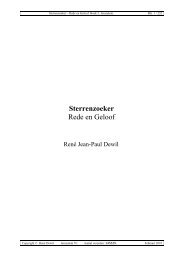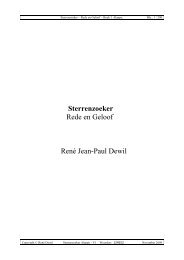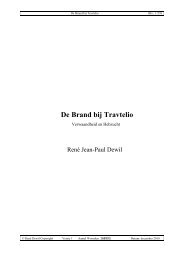A visual Journey into the Bible The Book of Genesis
A visual Journey into the Bible The Book of Genesis
A visual Journey into the Bible The Book of Genesis
Create successful ePaper yourself
Turn your PDF publications into a flip-book with our unique Google optimized e-Paper software.
A Visual <strong>Journey</strong> <strong>into</strong> <strong>the</strong> <strong>Bible</strong> Page: 34<br />
sits on <strong>the</strong> right, in a pure Michelangelo attitude so that his powerful muscles show.<br />
<strong>The</strong> painting <strong>the</strong>refore, by its content and <strong>the</strong> poises <strong>of</strong> its figures could be considered<br />
as a typical academic work <strong>of</strong> a French scholar in Rome. But Léon Bonnat, through<br />
his use <strong>of</strong> light in <strong>the</strong> picture and through his deep colours, broke down <strong>the</strong> academic<br />
treatment <strong>of</strong> <strong>the</strong> subject.<br />
Abel lies on <strong>the</strong> rocks. Here, Bonnat used magnificent golden colours. He let <strong>the</strong> light<br />
cover Abel and bring his fine, thin chest be <strong>the</strong> central area <strong>of</strong> <strong>the</strong> painting. Abel is<br />
indeed shown like a Jesus, a young, delicate man with slender traits and limbs, elegant<br />
long arms and legs. When we compare Abel with Adam, we are quite surprised since<br />
Abel is so much more exquisite, more vulnerable in <strong>the</strong> barren, terrible desert <strong>into</strong><br />
which Adam and Eve and <strong>the</strong>ir family have been banished. Abel’s head hangs over<br />
Eve’s knees, lifeless but as if sleeping and caressed by his mo<strong>the</strong>r.<br />
Eve is seated. She holds her hands to her breast. She looks at her son. She is still a<br />
young woman. She is serene, sullen, in apathy, in solemn sadness at so much hardness<br />
<strong>of</strong> life, east <strong>of</strong> Eden, and at <strong>the</strong> death <strong>of</strong> her son. <strong>The</strong> golden light plays a little also on<br />
her bare shoulders. Abel truly is her son, because he is as delicate as she is. Eve looks<br />
at her son only. She looks intensely and lost to <strong>the</strong> world. She is alone, isolated, and<br />
far from Adam. She makes no gesture <strong>of</strong> horror. Adam is not with her. She is one with<br />
her son.<br />
Adam sits to <strong>the</strong> right. He sits in a position like Michelangelo could have imagined for<br />
a sculpture. Adam sits on his knees but his torso is turned so that Bonnat could paint<br />
all <strong>the</strong> muscles <strong>of</strong> his powerful back. Adam sits like a wrestler and he is out <strong>of</strong> <strong>the</strong><br />
scene <strong>of</strong> Eve and Abel. He does not belong to <strong>the</strong> scene <strong>of</strong> grief, to <strong>the</strong> intimate<br />
symbiosis <strong>of</strong> mo<strong>the</strong>r and son. He is <strong>the</strong> Hercules, <strong>the</strong> Vulcan <strong>of</strong> later times. He did not<br />
choose Eve. Already <strong>the</strong> first couple, Adam and Eve, are distinct, separate, each<br />
lonely, and too different to be able to sit toge<strong>the</strong>r to mourn. <strong>The</strong>y mourn so<br />
differently. Eve is resigned; Adam drawing restless on his muscles, pulling <strong>the</strong>m <strong>into</strong><br />
tension as if he were preparing to fight fate. Adam is a brute who continues to turn<br />
and contort his body. Eve is s<strong>of</strong>tness and she is turned inwards; Adam is all outwardly<br />
but futile display <strong>of</strong> force. <strong>The</strong> force is useless, spent, and <strong>the</strong> protest, <strong>the</strong> overt show<br />
<strong>of</strong> power <strong>of</strong> Adam is in vain. Abel lies between Adam and Eve and both parents seem<br />
to know that this death is more <strong>the</strong> result <strong>of</strong> <strong>the</strong> old sin, <strong>the</strong> old trespassing <strong>of</strong> God’s<br />
command than a battle <strong>of</strong> life. As compared to <strong>the</strong> act <strong>of</strong> sin, <strong>the</strong> roles are reversed<br />
since Eve is resigned and Adam revolts.<br />
Léon Bonnat worked fully <strong>the</strong> contrasts between light and shadow in <strong>the</strong> Baroque<br />
way. That also was new in a period where <strong>the</strong> Academy was much given over to <strong>the</strong><br />
legacy <strong>of</strong> Jean-Auguste Dominique Ingres and Jacques-Louis David. One would have<br />
expected a clear scene, clear lines, and only fine indications <strong>of</strong> forms. Bonnat returned<br />
to <strong>the</strong> Caravaggesque use <strong>of</strong> light. <strong>The</strong> light on Abel is splendid and bright. It<br />
continues to flow over his body <strong>into</strong> <strong>the</strong> sandy valley beyond. Some light also falls on<br />
Eve, sculpting her round and s<strong>of</strong>t forms, whereas Abel is all angular and sharper in<br />
<strong>the</strong> harsh light. Eve’s head is in <strong>the</strong> shadows. Adam is much more in <strong>the</strong> dark, since<br />
grief <strong>of</strong> a man should not be shown. His bronze shoulders merely emerge from <strong>the</strong><br />
night and <strong>the</strong> shadows seem to creep over him, engulf him from <strong>the</strong> right side so that<br />
he becomes one with <strong>the</strong> black rocks behind him. Caravaggio would still have painted<br />
Adam’s face in all detail and in some light. Bonnat hides <strong>the</strong> face. Adam’s<br />
Copyright ©: René Dewil Date: October, 24 2000











